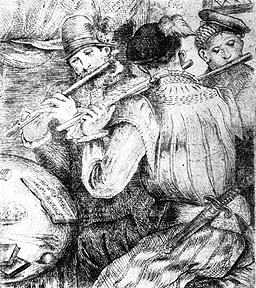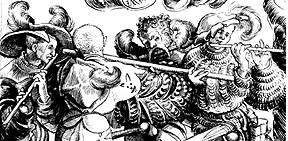The transverse flute dates back to Roman times (from which one bone specimen has survived), but it drops out of use in Europe until the llth or l2th century. The medieval and Renaissance instrument is simply a cylindrical wooden tube stopped at one end, with a mouth-hole and six fingerholes.
Flute quartet. Flute music of the 16th and 17th centuries. Nancy Hadden, director. Hyperion CDA66298 (1989). Trk 3 Was wird es doch.
The Renaissance flute came in three basic sizes which sometimes formed a consort, but the middle size, or tenor, was much more popular than the others and seems often to have been combined with other soft instruments. The bass flute is particularly awkward to play because of its wide finger stretch and the alto flute is a little shrill, so it’s not surprising that the tenor was preferred, even functioning regularly as the top part in ensembles. This use was made possible by the flute_s range of more than two octaves.
Renaissance flute and lute. Saltarello, Baxela un tratto (Anon., early 16th century) performed by Nancy Hadden and Christopher Wilson. Renaissance Music of the Courts of Mantua and Ferrarra, Circa 1500. Chandos 8333 (1984). Trk. 3.
The sound of the Renaissance flute is a little more airy or breathy than that of the recorder, but it blends well in ensemble (see broken consort) and can be highly expressive.




